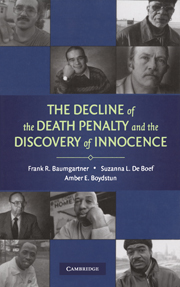Book contents
- Frontmatter
- Contents
- List of Tables
- List of Figures
- Acknowledgments
- 1 Innocence and the Death Penalty Debate
- 2 The Death Penalty in America
- 3 A Chronology of Innocence
- 4 The Shifting Terms of Debate
- 5 Innocence, Resonance, and Old Arguments Made New Again
- 6 Public Opinion
- 7 The Rise and Fall of a Public Policy
- 8 Conclusion
- Epilogue: Individuals Exonerated from Death Row
- Appendix A New York Times capital punishment coverage, 1960 to 2005
- Appendix B Description of Data
- Notes
- References
- Index
3 - A Chronology of Innocence
Published online by Cambridge University Press: 05 September 2012
- Frontmatter
- Contents
- List of Tables
- List of Figures
- Acknowledgments
- 1 Innocence and the Death Penalty Debate
- 2 The Death Penalty in America
- 3 A Chronology of Innocence
- 4 The Shifting Terms of Debate
- 5 Innocence, Resonance, and Old Arguments Made New Again
- 6 Public Opinion
- 7 The Rise and Fall of a Public Policy
- 8 Conclusion
- Epilogue: Individuals Exonerated from Death Row
- Appendix A New York Times capital punishment coverage, 1960 to 2005
- Appendix B Description of Data
- Notes
- References
- Index
Summary
Americans discovered innocence in a wave of attention that started in the mid-1980s and reached a peak in the late 1990s. In this chapter, we review developments that led to this outcome. We know from the previous chapter that, although there are somewhat higher numbers of exonerations now than there were in the 1970s and 1980s, the increase was not radical. Attention to the concept of innocence, on the other hand, has spiked dramatically. Why attention to a concept would spike even while the underlying facts have changed only slowly is an interesting puzzle. To answer the puzzle, we look in some detail at threshold effects and social cascades.
Here, we investigate how the innocence frame came to dominate public debate. We begin by offering a meticulous chronology as presented in five separate lists. We first review developments among the most important organizations and institutions involved in the movement, especially the so-called innocence projects at many law and journalism schools; then we look at key events in Illinois, where many of the innocence arguments first gained attention; trace noteworthy events elsewhere in the country; consider federal government actions; and finally look at important Supreme Court rulings. We examine these developments in relatively stark detail to understand when the innocence frame took root, how it developed, and how it came to flood the death penalty debate. Was there a prime mover of sorts, perhaps a powerful lobbying group or a network of journalists pursuing a political agenda?
- Type
- Chapter
- Information
- Publisher: Cambridge University PressPrint publication year: 2008

